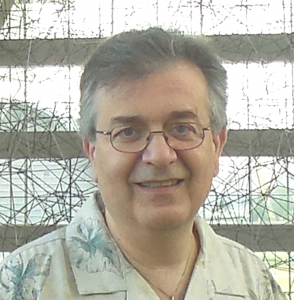 Nosso entrevistado do mês de dezembro é Gleison Adriano da Silva, um dos vencedores da 13ª edição do Prêmio Destaque na Iniciação Científica e Tecnológica do Conselho Nacional de Desenvolvimento Científico e Tecnológico (CNPq). O jovem, que em novembro se diplomou bacharel em Física pela Universidade Federal do Amazonas (UFAM), ganhou o prêmio de iniciação científica da área de Ciências Exatas, da Terra e Engenharias por um trabalho de sobre caracterização estrutural, térmica e óptica de sistemas semicondutores. O prêmio do CNPq distinguiu seis trabalhos (o melhor de iniciação científica e o melhor de iniciação tecnológica de cada grande área do conhecimento) dentre 467 inscritos, enviados por 167 instituições de ensino e pesquisa do Brasil.
Nosso entrevistado do mês de dezembro é Gleison Adriano da Silva, um dos vencedores da 13ª edição do Prêmio Destaque na Iniciação Científica e Tecnológica do Conselho Nacional de Desenvolvimento Científico e Tecnológico (CNPq). O jovem, que em novembro se diplomou bacharel em Física pela Universidade Federal do Amazonas (UFAM), ganhou o prêmio de iniciação científica da área de Ciências Exatas, da Terra e Engenharias por um trabalho de sobre caracterização estrutural, térmica e óptica de sistemas semicondutores. O prêmio do CNPq distinguiu seis trabalhos (o melhor de iniciação científica e o melhor de iniciação tecnológica de cada grande área do conhecimento) dentre 467 inscritos, enviados por 167 instituições de ensino e pesquisa do Brasil.
O trabalho que valeu o prêmio a Gleison foi desenvolvido ao longo de três projetos de iniciação científica que o jovem realizou no contexto do Grupo de Materiais do Departamento de Física da UFAM, com orientação do professor Sérgio Michielon de Souza e com financiamento da Fundação de Amparo à Pesquisa do Estado do Amazonas (FAPEAM) e do CNPq. Nesses projetos, foram sintetizados materiais nanoestruturados semicondutores por meio de um processo simples e de baixo custo. Os materiais foram analisados por meio das técnicas de difração de raios X, calorimetria diferencial de varredura, micro-Raman e espectroscopia de absorção fotoacústica, e demonstraram um bom potencial para serem usados como materiais termoelétricos na transformação direta de calor em eletricidade.
Gleison se tornou bolsista de iniciação científica (inicialmente da FAPEAM e depois do CNPq) pouco depois de entrar no curso de bacharelado em Física da UFAM, em 2011. Seu orientador, Sérgio Michielon de Souza, tinha se tornado docente dessa instituição no mesmo ano e estava montando o Laboratório de Materiais no Departamento de Física, processo do qual Gleison participou ativamente. A primeira fase do trabalho foi dedicada à fabricação e estudo do sistema Cd-Se, e seus resultados foram publicados [http://dx.doi.org/10.1016/j.
Finalmente, em julho de 2016, Gleison teve a grande satisfação de receber o Prêmio Destaque na Iniciação Científica e Tecnológica, em Porto Seguro (BA), durante a 68ª Reunião Anual da Sociedade Brasileira para o Progresso da Ciência (SBPC). Era a terceira vez que o estudante era indicado pela Pró-reitoria de Pesquisa e Pós-Graduação da UFAM para concorrer ao prêmio do CNPq, e dessa vez conquistou a distinção com os resultados finais da pesquisa sobre o sistema Ni-Sb e os resultados parciais da pesquisa sobre o sistema Sn-Se. Três meses depois, Gleison defendeu seu trabalho de conclusão de curso (TCC), elaborado a partir dos estudos com os sistemas Ni-Sb e Sn-Se, e obteve o título de bacharel em Física pela UFAM.
Veja nossa entrevista com Gleison.
Boletim da SBPMat: – Onde você nasceu? Onde morou até iniciar os estudos universitários na UFAM?
Gleison Adriano da Silva: – Sou natural do Brasil Central, Brasília (DF), e tudo começou em 2008 quando me candidatei a missionário/ agente comunitário da Diocese de Roraima na Região Norte do Brasil, sob comando do antigo bispo titular Dom Roque Paloscci, para trabalhar em comunidades no baixo Rio Branco até a sua foz no Rio Negro. Em 2009, prestei o ENEM com êxito para Engenharia Florestal na UFAM, campus Manaus (AM). Sem auxílio financeiro, fui morar em um albergue no Centro de Manaus (AM), entretanto, após processo seletivo na Pró-Reitoria de Assuntos Comunitários, passei a morador da Casa do Estudante Universitário da UFAM. Em 2011, por falta de afinidade ao curso Engenharia Florestal, mudei para o curso bacharelado em Física do Instituto de Ciências Exatas da UFAM.
Boletim da SBPMat: – Poderia nos contar muito brevemente como começou o seu interesse pela ciência e/ou pela pesquisa? Foi na universidade, na infância, na escola?
Gleison Adriano da Silva: – Tudo aconteceu muito rápido. Ao ingressar no curso bacharelado em Física da UFAM, já iniciei na pesquisa científica à convite do Prof. Dr. Sérgio Michielon de Souza e, dada minha inserção junto ao Grupo de Pesquisa em Materiais do Depto de Física da UFAM, pude ter a oportunidade de realizar investigações científicas voltadas na determinação de estruturas cristalinas, evolução micro/nano-estrutural e transformação de fases em materiais intermetálicos utilizando softwares computacionais e técnicas analíticas no Laboratório de Materiais.
Boletim da SBPMat: – Qual é, na sua visão, a principal contribuição contida do trabalho premiado? Ou, quais são as principais contribuições dos trabalhos premiados?
Gleison Adriano da Silva: – Uma observação interessante é que as investigações laureadas estavam coincidentemente relacionadas com os temas celebrativos da UNESCO de 2014 e 2015 intitulado como Ano Internacional da Cristalografia e Ano Internacional da Luz. Nesta perspectiva, as principais contribuições contidas nos trabalhos premiados estavam relacionadas a técnica de difração de raios X, ou seja, transformações e estabilidade de fases cristalográficas das amostras do sistema semicondutor Ni-Sb e Sn-Se durante a síntese de estado sólido, onde foi observado uma forte estabilidade estrutural nos cristais de antimoneto de níquel (NiSb) e uma notável metaestabilidade nos cristais de seleneto de estanho (SnSe).
Um trabalho simples que apresenta características microestruturais e termodinâmicas de dois novos materiais nanoestruturados de interesse científico e tecnológico submetido a uma rota de síntese não complexa e de baixo custo.
Boletim da SBPMat: – Quais foram os critérios que o guiaram para fazer uma pesquisa de qualidade destacada em nível nacional? A que fatores você atribui esta conquista?
Gleison Adriano da Silva: – Não existe ovo de Colombo ou receita de sucesso, só muito trabalho. Nada acontece sem esforço. Como bolsista na iniciação científica eu sempre fui o primeiro a chegar e o último a sair do laboratório. A conquista é reconhecimento do trabalho, entretanto, ninguém consegue nada sozinho.
Boletim da SBPMat: – Convidamos você a deixar alguma mensagem para nossos leitores que estão realizando trabalhos de iniciação científica na área de Materiais.
Gleison Adriano da Silva: – Acreditem no potencial de vocês e no potencial de suas investigações. O sonho é o que move agente, mas não basta só sonhar, tem que correr atrás. Considerem isso também como um incentivo para divulgação de seus resultados em eventos científicos pelo Brasil, em especial nos Encontros Anuais da SBPMat.
Boletim da SBPMat: – O que você fará ou planeja fazer agora que terminou a graduação.
Gleison Adriano da Silva: – Após a saga da graduação, provavelmente procurarei um Programa de Pós-Graduação na Universidade de Brasília (UnB) ou em alguma renomada instituição paulista.
Boletim da SBPMat: – Fique à vontade para outro breve comentário, se desejar.
Gleison Adriano da Silva: – Gostaria de agradecer as cartas de congratulações e aplausos expedidas pelo Chefe do Depto de Física da UFAM, Senhor Prof. Me. Marcílio de Freitas; pela Diretora-Presidente da FAPEAM, Senhora Profa. Dra. Maria Olívia de Albuquerque Ribeiro Simão; e pela Senhora Senadora Vanessa Grazziotin da câmara alta do Congresso Nacional do Brasil (http://www.senado.leg.br/
Também, gostaria de agradecer a cidade de Manaus (AM), a UFAM e a todas as pessoas que direta e/ou indiretamente contribuíram para a minha formação pessoal e acadêmica.


